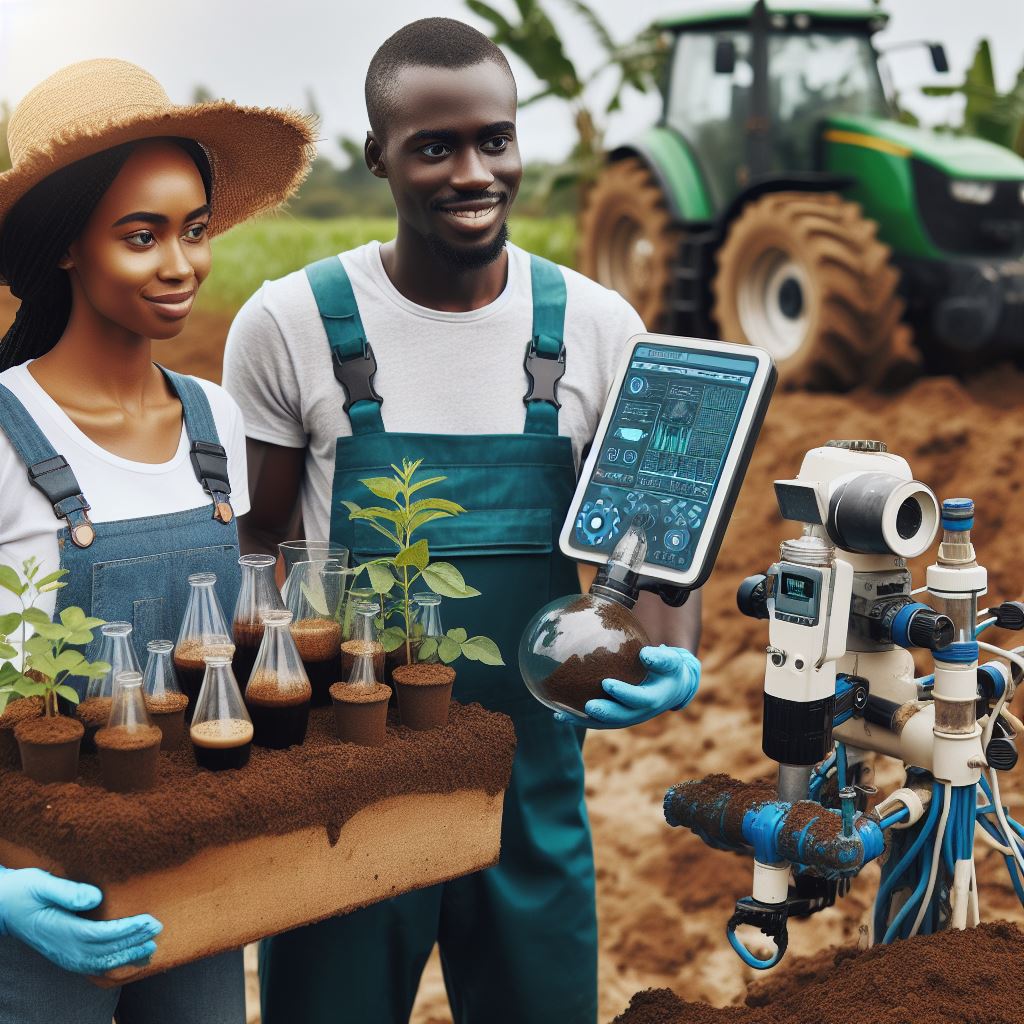Introduction
Soil analysis is crucial for farmers as it helps optimize crop production and manage soil health. It provides essential insights into soil health, nutrient levels, and pH balance, enabling informed decision-making for optimal crop growth.
By assessing soil composition, farmers can tailor fertilizer application, improving resource efficiency and reducing costs. This analysis also helps prevent over-fertilization, minimizing environmental impact.
Additionally, understanding soil characteristics aids in selecting suitable crops and implementing appropriate cultivation practices. Regular soil testing enhances long-term sustainability, ensuring productive yields while preserving the ecosystem.
In essence, soil analysis empowers farmers with data-driven strategies, fostering agricultural sustainability, and maximizing crop quality and quantity.
Recent technological advancements have revolutionized soil analysis, making it more accurate and efficient.
Recent advancements in soil analysis technology have revolutionized agricultural practices. Precision agriculture now relies on cutting-edge tools like remote sensing, GPS, and drones to collect data on soil composition and health.
Advanced sensors and machine learning algorithms enable real-time monitoring, allowing farmers to make informed decisions about irrigation, fertilization, and crop management.
DNA-based techniques provide detailed insights into microbial communities, aiding in understanding soil biodiversity.
These technological strides enhance resource efficiency, reduce environmental impact, and optimize crop yields, fostering sustainable farming practices.
Overall, these innovations in soil analysis empower farmers with actionable information for improved productivity and environmental stewardship.
Traditional Methods of Soil Analysis
Overview of traditional soil sampling and testing
- Soil sampling involves collecting small quantities of soil from different locations in a field.
- These samples are then sent to a laboratory, where various tests are conducted.
- Tests include nutrient analysis, pH levels, organic matter content, and presence of contaminants.
- Results help farmers make informed decisions about fertilizer application and plant selection.
Limitations and drawbacks of traditional methods
- Traditional soil testing is time-consuming and requires labor to collect and send samples
. - It can take weeks to receive results from the laboratory, delaying farm management decisions.
- Traditional methods provide a limited snapshot of soil conditions in specific areas of the field.
- Sampling from a few locations may not fully represent the variability across the entire field.
- Traditional methods do not account for spatial variation and can be costly for large farms.
- They may not provide real-time information about soil conditions and changes over time.
Overall, traditional soil analysis methods have served farmers for many years, but they have limitations.
However, recent advancements in technology have introduced high-tech solutions for soil analysis.
High-Tech Soil Analysis Techniques
Remote sensing and satellite imagery
Remote sensing and satellite imagery have revolutionized the way farmers analyze and understand their soil. This high-tech approach helps farmers make informed decisions and manage their fields more efficiently.
Using remote sensing for soil analysis offers several benefits. It allows farmers to assess soil conditions over large areas without physically visiting each location. This saves time, effort, and resources.
Remote sensing also provides real-time data on soil moisture, nutrient levels, and crop health, enabling farmers to tailor their irrigation and fertilization practices accordingly.
Transform Your Agribusiness
Unlock your farm's potential with expert advice tailored to your needs. Get actionable steps that drive real results.
Get StartedPrecision agriculture and sensor technologies
Precision agriculture relies on sensor tech for soil analysis, aiming to optimize productivity and reduce waste. Sensors gather data on moisture, temperature, pH, and nutrients in the soil.
Data aids in determining field sections’ specific needs, optimizing fertilizer and water application. Moisture sensors gauge soil moisture for optimal irrigation timing. Temperature sensors track soil temperature, impacting crop growth and nutrient availability.
Conductivity sensors measure soil electrical conductivity, indicating salinity and nutrient levels. Spectrometers analyze plant-reflected light for health and nutrient insights. These technologies enable farmers to make informed decisions, enhancing crop yield and sustainability.
DNA sequencing and microbial analysis
In addition to remote sensing and precision agriculture, DNA sequencing is a significant tool for soil analysis. DNA sequencing allows farmers to assess the genetic diversity and composition of the soil microbiome.
By understanding the microbial community present in the soil, farmers can determine its health and potential for nutrient cycling. Identifying specific microorganisms can also help detect and manage soil-borne diseases.
Microbial analysis is another valuable technique for soil analysis. It provides insights into the microbial population and its functional diversity.
Microbes play critical roles in nutrient cycling, soil structure formation, and plant health. Analyzing the microbial composition helps farmers understand soil fertility and potential risks such as soil degradation and pathogen outbreaks.
This knowledge allows farmers to implement soil management practices that promote beneficial microbial activity and overall soil health.
In fact, high-tech soil analysis techniques have revolutionized farming practices.
Remote sensing and sensor technologies provide real-time data on soil conditions, enabling farmers to make informed decisions regarding irrigation, fertilization, and crop health management.
DNA sequencing and microbial analysis enhance our understanding of soil health, fertility, and disease risks.
By utilizing these techniques, farmers can optimize their agricultural practices and improve yield while minimizing environmental impact.
Read: Organic Fertilizers: Boosting Soil Health
Benefits of High-Tech Soil Analysis for Farmers
Increased accuracy and reliability of results
High-tech soil analysis tools provide farmers with more precise and dependable results for their crops.
Farmers can make informed decisions based on accurate data, leading to better overall farm management.
Enhanced understanding of soil composition and fertility
By utilizing high-tech soil analysis, farmers can gain a deeper knowledge of their soil’s nutrient content and structure.
They can identify deficiencies and adjust their farming practices accordingly to maximize crop productivity.
Improved crop yield and quality
High-tech soil analysis enables farmers to optimize their farming techniques and create ideal growing conditions.
By providing the necessary nutrients and addressing soil imbalances, farmers can enhance both yield and crop quality.
Cost savings from optimizing fertilizer and agrochemical usage
Accurate soil analysis allows farmers to precisely determine the appropriate amount of fertilizer and agrochemicals.
This targeted approach eliminates waste, reducing costs and minimizing environmental impact.
Overall, high-tech soil analysis offers numerous benefits to farmers, improving their agricultural practices and productivity.
By harnessing advanced tools and techniques, farmers can optimize their operations, leading to higher yields and better quality crops.
Moreover, they can save costs by ensuring the efficient use of fertilizers and agrochemicals.
Showcase Your Farming Business
Publish your professional farming services profile on our blog for a one-time fee of $200 and reach a dedicated audience of farmers and agribusiness owners.
Publish Your ProfileUltimately, this technology-driven approach not only benefits farmers but also contributes to sustainable farming and environmental conservation.
Read: Cotton Cultivation: Best Practices and Tips
Challenges and Considerations
Cost of adopting high-tech soil analysis technologies
- High-tech soil analysis technologies can be expensive, making it challenging for farmers to adopt them.
- The initial investment required for purchasing advanced equipment and software can be prohibitive.
- Farmers may struggle to find the necessary funds to invest in these technologies, especially smaller-scale or resource-limited farmers.
- Ongoing costs, such as maintenance, calibration, and software updates, should also be considered.
- The cost-effectiveness of these technologies should be carefully evaluated to ensure long-term benefits outweigh the expenses.
Limited access and availability of advanced tools
1. Availability of high-tech soil analysis tools may be limited, especially in rural areas or developing countries.
2. Farmers in remote regions may face difficulties in accessing and procuring these advanced tools.
3. The lack of infrastructure and distribution networks can further hinder the availability of these technologies.
4. Limited availability often leads to increased competition and inflated prices in regions where these tools are accessible.
5. Collaborations among governments, private sectors, and international organizations can help improve access to these tools.
Technical expertise and training required for implementation
- Successful implementation of high-tech soil analysis technologies requires technical expertise and proper training.
- Farmers need to understand how to use the tools effectively and interpret the results accurately.
- Lack of technical knowledge can lead to misinterpretation of data, resulting in ineffective soil management practices.
- Farmers may need guidance in choosing the right technology suitable for their specific soil conditions and crop requirements.
- Continuous training and support should be provided to farmers to ensure effective adoption and utilization of these technologies.
In all, while high-tech soil analysis technologies offer many benefits to farmers, there are several challenges and considerations that need to be addressed.
The cost of adopting these technologies can be a barrier, particularly for farmers with limited financial resources. Additionally, limited access and availability of advanced tools can hinder implementation in rural areas.
Furthermore, technical expertise and training are crucial for farmers to make the most of these technologies.
Addressing these challenges through affordable solutions, improved access, and training programs can help farmers fully utilize the potential of high-tech soil analysis for optimizing crop productivity and sustainable agriculture practices.
Read: Integrated Pest Management for Fruit Trees

Uncover the Details: Crop Productivity: Winning Over Weeds
Case Studies and Success Stories
These case studies and success stories demonstrate the transformative effects of high-tech soil analysis on farmers’ practices and outcomes.
By harnessing the power of advanced technology, farmers can gain valuable insights into their soil composition and make informed decisions to optimize their farming techniques.
Let’s take a closer look at some examples where farms have successfully utilized high-tech soil analysis.
Examples of farms utilizing high-tech soil analysis:
- Smith Family Farm in Iowa decided to integrate high-tech soil analysis into their farming practices. By using sophisticated soil testing equipment, they were able to accurately assess their soil’s nutrient content, pH levels, and overall fertility. These detailed soil analysis reports helped them understand their soil better and make data-driven decisions regarding fertilizer applications.
- Green Acres Farm in California faced challenges with nutrient deficiencies in their soil, affecting crop growth and productivity. Through high-tech soil analysis, they were able to identify specific nutrient deficiencies and adjust their fertilizer blends accordingly. This targeted approach resulted in healthier plants, improved yield, and higher-quality crops.
- Jones Organic Farm in Vermont recognized the potential of high-tech soil analysis in organic farming. By utilizing advanced soil testing technologies, they obtained comprehensive insights into their soil’s organic matter, microorganism populations, and nutrient availability. Armed with this knowledge, they tailored their crop rotation and cover crop strategies, leading to increased soil fertility and a significant boost in crop yield.
Positive outcomes and impacts on their farming practices
- Smith Family Farm experienced tangible benefits from implementing high-tech soil analysis. By fine-tuning their fertilizer applications based on precise soil analysis data, they reduced their fertilizer costs by 20% without compromising crop quality. This cost-saving measure significantly improved their overall profitability and sustainability.
- Green Acres Farm’s commitment to utilizing high-tech soil analysis paid off in terms of crop quality. Identifying and addressing nutrient deficiencies detected through soil analysis resulted in a remarkable 30% improvement in the quality of their harvest. Their produce became more marketable, garnering positive feedback from customers and increasing their revenue.
- Jones Organic Farm’s adoption of high-tech soil analysis led to a positive shift in their farming practices. The detailed soil analysis reports guided them in implementing targeted interventions, such as incorporating specific cover crops and adjusting organic soil amendments. As a result, they witnessed a 15% increase in crop yield, ensuring a more sustainable organic farming operation.
These case studies exemplify the concrete benefits of high-tech soil analysis for farmers. By leveraging advanced technology and accurate soil data, farmers can optimize their fertilizer use, address nutrient deficiencies, and enhance overall soil fertility.
This enables them to achieve higher crop yields, improve crop quality, and make informed decisions that positively impact their farming practices.
Read: Greenhouse Growing: Tips for Better Yields
Discover More: Mastering Weed Eradication in Crop Fields
Future of High-Tech Soil Analysis
Emerging trends and advancements in soil analysis technology
New sensors and IoT devices are being developed to enhance soil analysis accuracy and efficiency.Drones equipped with advanced imaging and sensors can provide real-time data for precise soil analysis.
High-resolution satellite imagery combined with machine learning algorithms can revolutionize soil analysis methods.Advancements in DNA sequencing and microbiome analysis offer deeper insights into soil health and composition.
Blockchain technology can be utilized to securely store and share soil analysis data across different stakeholders.
Potential benefits and opportunities for farmers
Accurate high-tech soil analysis can optimize fertilizer and water usage, reducing costs and environmental impact.Real-time analysis enables farmers to make informed decisions regarding crop selection and planting techniques.
Early detection of nutrient deficiencies or soil diseases can prevent crop loss and improve overall farm productivity.Access to comprehensive soil data can assist in land management and improve crop rotation strategies.
High-tech soil analysis provides a scientific basis for precision farming practices, maximizing yields and profitability. Sharing soil analysis results with buyers can enhance transparency and add value to agricultural products.
The potential challenges and limitations
High-tech soil analysis technologies can be expensive, making them inaccessible to small-scale farmers.Proper training and technical expertise are required to interpret and utilize the data effectively.
Data privacy and ownership issues must be addressed to ensure the integrity and security of soil analysis data.Integration of different soil analysis technologies and data platforms can be complex and time-consuming.
Reliability and accuracy of soil analysis technologies need to be thoroughly validated to gain farmer trust.
The future outlook and brief
The future of high-tech soil analysis looks promising, with continuous advancements and emerging technologies.Efforts should be made to make soil analysis technologies more affordable and accessible to all farmers.
Collaboration between researchers, technology developers, and farmers is crucial to drive innovation in this field.Policymakers should prioritize funding and support for the development and adoption of high-tech soil analysis methods.
By embracing high-tech soil analysis, farmers can enhance productivity, sustainability, and profitability in agriculture.
Generally, the future of high-tech soil analysis holds immense potential for revolutionizing farming practices.
Emerging trends in soil analysis technology, such as IoT devices, drones, and machine learning, offer new possibilities for accurate and efficient soil analysis.
Farmers can benefit from optimized resource usage, improved decision-making, and enhanced productivity. However, challenges related to cost, data integration, and privacy need to be addressed.
With collaborations and support from various stakeholders, high-tech soil analysis can pave the way for a more sustainable and profitable agricultural sector.
Conclusion
High-tech soil analysis is crucial for farmers as it provides valuable insights into soil health and nutrient content.
It provides detailed insights into soil health, nutrient levels, and composition.
This data enables precise and efficient crop management, optimizing fertilizer use and preventing over-application.
Accurate soil information helps farmers make informed decisions on crop selection, irrigation, and pest control, leading to increased yields and sustainable agriculture.
Real-time monitoring through advanced technologies enhances adaptability to changing conditions, mitigating risks and improving overall farm productivity.
High -tech soil analysis empowers farmers with essential information, fostering sustainable practices and ensuring the long-term health and productivity of agricultural land.
By embracing and exploring these technologies, farmers can enhance their crop production and reduce environmental impacts.
[E-Books for Sale]
500 Farming Tax Laws Simplified: The Ultimate Global Guide for Farmers
$19.99 • 500 Farming Tax Laws • 154 pages
Maximize your farm’s savings with 500 simplified tax laws, tips, and strategies in this essential farmer’s guide!
See All 500 Farming Tax Laws of this E-Book
2,000 Technological Solutions to Revolutionize Your Agribusiness: A Comprehensive Global Guide for Farmers
$19.99 • 2,000 Technological Solutions • 343 pages
Discover 2,000 cutting-edge technologies to transform your agribusiness. Boost productivity and sustainability today!




